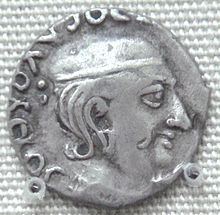Reign 130–150 CE Parents Jayadaman | Died 150 AD Grandparent Chastana | |
 | ||
People also search for Chastana, Yavaneśvara, Gautamiputra Satakarni | ||
Rudradaman I (r. 130–150) was a Saka ruler from the Western Kshatrapas dynasty. He was the grandson of the king Chastana. Rudradaman I was instrumental in the decline of the Satavahana Empire.
Contents
Mahakshatrapa
Rudradama I took up the title of Maha-kshtrapa ("Great Satrap"), after he became the king and then strengthened his kingdom. During his reign he married a Hindu woman and converted to Hinduism Quoting from the book Buddhist critical spirituality: Prajñā and Śūnyatā, the author Shōhei Ichimura speaks thus about him,
"Rudradama's inscription, written in Brahmi script, was the earliest record ever written in perfect Sanskrit....
As mentioned before, Rudradama did not mention his religious affiliation with the Buddhist Sangha, perhaps because the House of Chastana had been affiliated with the Jaina religion for generations. But, in the matter of religion, neither did he mention his affiliation with Jaina at all."
Victory over the Satavahana
He maintained matrimonial relationships with Satavahanas and conceded the country of Aparanta to Vashishtiputra Satakarni, his son-in-law and probably son or grandson of Gautamiputra Satakarni, as dowry. In spite of the matrimonial link, at least two wars took place between them wherein he defeated Satavahanas but spared the life of Satakarni (probably, Vashishtiputra Satakarni), essentially because of their relationship. However, it is not known who was the aggressor in either of the wars and whether there were more wars between them.
"Rudradaman (...) who obtained good report because he, in spite of having twice in fair fight completely defeated Satakarni, the lord of Dakshinapatha, on account of the nearness of their connection did not destroy him."
As a result of his victories, Rudradaman regained all the former territories previously held by Nahapana, except for the southern territory of Poona and Nasik. Satavahana dominions were limited to their original base in the Deccan and eastern central India around Amaravati:
"Rudradaman (...) who is the lord of the whole of eastern and western Akaravanti (Akara: East Malwa and Avanti: West Malwa), the Anupa country, Anarta, Surashtra, Svabhra (northern Gujarat) Maru (Marwar), Kachchha (Cutch), Sindhu-Sauvira (Sindh and Multan districts), Kukura (Eastern Rajputana), Aparanta ("Western Border" - Northern Konkan), Nishada (an aboriginal tribe, Malwa and parts of Central India) and other territories gained by his own valour, the towns, marts and rural parts of which are never troubled by robbers, snakes, wild beasts, diseases and the like, where all subjects are attached to him, (and) where through his might the objects of [religion], wealth and pleasure [are duly attained]".
While most of the scholars, following Rapson believe that Rudradaman ruled from Ujjain, there is no such evidence to support this. In fact, there is evidence to prove the contrary:
- Jain sources mention that after Nahapana (40 years) and Gardabhilas (15 years), Sakas will rule Ujjain but for only four years. Chastana no doubt has ruled Ujjain but he must have ruled it only for four years. His son Jayadaman (a Kshatrapa as against Castana being a Mahaksatrapa) was an ineffectual king and lost most of the territory won by Castana. This must have included all important Ujjain as well.
- Natural History of Claudius Ptolemy in 160 CE record Castana as the king of Avanti while it is known that it is Rudradaman who was ruling between 130 and 150 CE. Ptolemy was obviously referring only to the last best known ruler and if Rudradaman was ruling Avanti, he would have mentioned him, since he was certainly well known through his conquests.
- Truly speaking, Rudradaman made no reference to Avanti. He said he conquered Eastern and Western Akaravanti (Eastern Malwa) - Western Akaravanti being land lying east to Bhopal, which does not include any western part of Malwa or Avanti. Akaravanti, earlier called as Sudarsana, comprised only Eastern Malwa. Western Akaravanti does not refer to Avanti.
Other facts
The Sanskrit Junagadh inscription dated 150 CE credits Rudradaman I with supporting the cultural arts and Sanskrit literature and repairing the dam built by the Mauryans. He in fact repaired the embankments of the lake Sudarshana, which was constructed by the Mauryas for checking floods.
Rudradaman fought many a battle against the Satavahanas (or the Andhras) and Satakarni, the son of the Andhra king Pulamayi, in an effort to end the hostilities, married the daughter of Rudradaman. Rudradaman also conquered the Yaudheya tribes in Haryana, as described in the Girnar inscription:
"Rudradaman (...) who by force destroyed the Yaudheyas who were loath to submit, rendered proud as they were by having manifested their' title of' heroes among all Kshatriyas."
However, in the next century the warlike Yaudheyas became more powerful. The indigenous Nagas also were aggressive toward Saka kshatrapas in the 3rd century.
Rudradaman is also known as the king who was ruling when the Greek writer Yavanesvara translated the Yavanajataka from Greek to Sanskrit, which influenced astrology in India.
